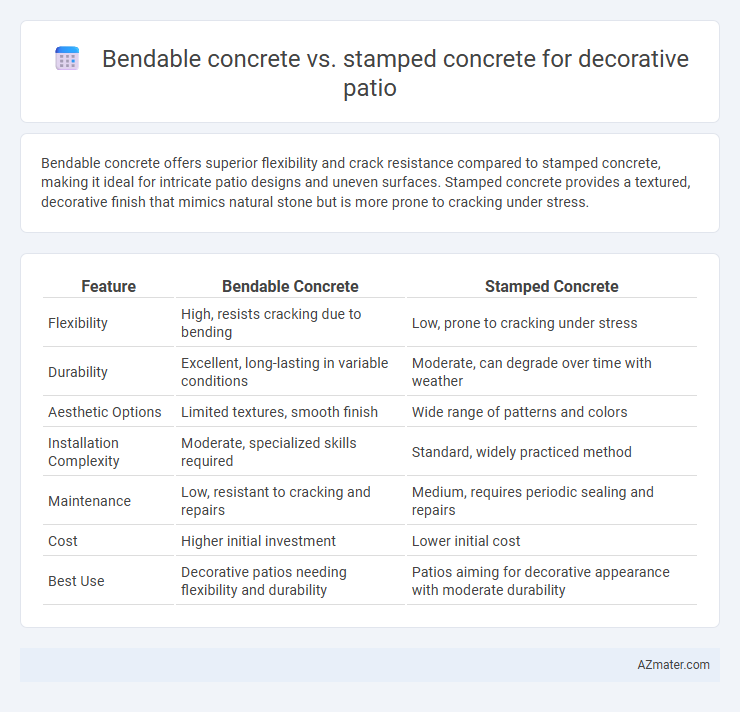Bendable concrete offers superior flexibility and crack resistance compared to stamped concrete, making it ideal for intricate patio designs and uneven surfaces. Stamped concrete provides a textured, decorative finish that mimics natural stone but is more prone to cracking under stress.
Table of Comparison
| Feature | Bendable Concrete | Stamped Concrete |
|---|---|---|
| Flexibility | High, resists cracking due to bending | Low, prone to cracking under stress |
| Durability | Excellent, long-lasting in variable conditions | Moderate, can degrade over time with weather |
| Aesthetic Options | Limited textures, smooth finish | Wide range of patterns and colors |
| Installation Complexity | Moderate, specialized skills required | Standard, widely practiced method |
| Maintenance | Low, resistant to cracking and repairs | Medium, requires periodic sealing and repairs |
| Cost | Higher initial investment | Lower initial cost |
| Best Use | Decorative patios needing flexibility and durability | Patios aiming for decorative appearance with moderate durability |
Introduction to Decorative Patio Surfaces
Decorative patio surfaces offer both aesthetic and functional benefits, with bendable concrete and stamped concrete emerging as popular choices. Bendable concrete features flexible properties that resist cracking and accommodate ground movement, ideal for outdoor patios subject to temperature fluctuations. Stamped concrete provides a durable surface with customizable patterns and textures, mimicking natural stone, brick, or wood to enhance visual appeal.
What is Bendable Concrete?
Bendable concrete, also known as engineered cementitious composite (ECC), is a flexible and durable material designed to withstand bending and cracking, making it ideal for decorative patios that require enhanced resilience. Unlike stamped concrete, which mimics textures like stone or brick through surface impressions, bendable concrete offers superior tensile strength and flexibility, reducing maintenance and repair over time. Its unique composition includes fibers that allow it to bend without breaking, providing long-lasting aesthetic appeal and structural integrity.
What is Stamped Concrete?
Stamped concrete is a decorative concrete technique that mimics the appearance of natural materials like stone, brick, or wood by imprinting unique patterns and textures onto freshly poured concrete. It offers durability and a wide variety of customizable designs, making it a popular choice for patios aiming to achieve an elegant, natural look without the high cost of authentic materials. Unlike bendable concrete, which is flexible and crack-resistant, stamped concrete is rigid and requires proper installation and sealing to maintain its aesthetic appeal and prevent damage over time.
Key Material Differences
Bendable concrete incorporates engineered fibers and polymers, offering enhanced flexibility and crack resistance compared to traditional stamped concrete, which relies on standard cement mixes molded into patterns for aesthetic appeal. The fiber-reinforced matrix in bendable concrete allows it to endure ground movement without fracturing, making it ideal for patios in areas with unstable soil or temperature fluctuations. Stamped concrete, while visually versatile due to various textures and colors, lacks the tensile strength of bendable concrete and is more prone to cracking under stress.
Strength and Durability Comparison
Bendable concrete exhibits significantly higher tensile strength and crack resistance due to its fiber-reinforced composition, making it ideal for decorative patios exposed to heavy loads or ground movement. Stamped concrete, while visually versatile with patterns and textures, tends to be more prone to surface cracking and wear under stress without specialized reinforcement. The increased durability of bendable concrete ensures longer-lasting performance with minimal maintenance compared to traditional stamped concrete options.
Design and Aesthetic Flexibility
Bendable concrete offers superior design and aesthetic flexibility compared to stamped concrete, allowing for curved, intricate shapes that mimic natural stone or wood seamlessly. Stamped concrete provides a wide variety of patterns and textures, but is limited by rigid molds and more conventional, flat surfaces. For decorative patios seeking unique, organic forms and customizable finishes, bendable concrete is a more versatile option.
Installation Process and Time
Bendable concrete requires a unique installation process involving flexible reinforcement mesh and specialized pouring techniques, allowing it to conform to curved surfaces, which typically takes longer due to precise handling and curing time. Stamped concrete installation involves pouring a standard concrete slab followed by pressing patterned molds into the surface before it fully sets, resulting in a faster application process often completed within a day or two. The complexity of bendable concrete installation generally increases labor time compared to the relatively straightforward and quicker process of stamped concrete for decorative patios.
Maintenance and Longevity
Bendable concrete, designed with high tensile strength fibers, offers superior crack resistance and requires less frequent repairs compared to stamped concrete, which is prone to chipping and wear from weather exposure. Maintenance for bendable concrete primarily involves regular cleaning, while stamped concrete demands periodic resealing to maintain its aesthetic appeal and prevent surface degradation. Over time, bendable concrete demonstrates greater longevity, sustaining structural integrity and appearance better than stamped concrete, which may deteriorate faster due to its porous surface and vulnerability to fading.
Cost Comparison: Bendable vs Stamped Concrete
Bendable concrete typically costs between $15 to $25 per square foot, reflecting its advanced polymer fiber reinforcement and flexibility, whereas stamped concrete usually ranges from $8 to $18 per square foot due to its traditional cement base and decorative stamping techniques. Bendable concrete's higher price is offset by its superior crack resistance and longer lifespan, reducing repair and maintenance expenses over time. Stamped concrete offers an economical decorative option upfront but may incur additional costs from frequent sealing and crack repairs.
Best Applications and Recommendations
Bendable concrete excels in decorative patios requiring high flexibility and crack resistance, making it ideal for areas with expansive soil or heavy foot traffic. Stamped concrete offers versatile aesthetic options with patterns and textures resembling stone, brick, or wood, best suited for patios where visual appeal takes precedence over structural flexibility. For optimal results, choose bendable concrete in climates with freeze-thaw cycles and uneven subgrades, while stamped concrete suits stable surfaces and projects emphasizing creative design.

Infographic: Bendable concrete vs Stamped concrete for Decorative patio
 azmater.com
azmater.com